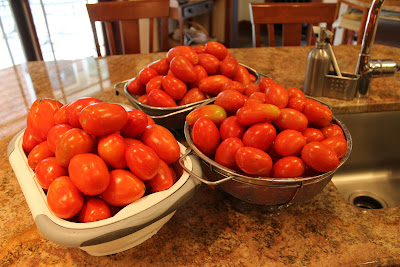This year, however, the weather has been so relentlessly awful that it rained all weekend which made the whole processing process way more fun than usual. Don't get me wrong, it's always a really satisfying endeavor -- since the outcome is a tidy array of our own veggies preserved to carry us through the winter. But when there's a whiff of fall crispness in the air and the sun is out, I'd really rather be trying to locate my errant golf shot, well hidden under a stray leaf, than toiling over steaming pots of tomato elixir. This year there was no such trade off. The golf course is so swamped that it's been closed for several days, and with the steady thrum of the rain audible through the kitchen fan chimney, I was able to throw myself into the Zen of tomatoes and thoroughly enjoy it.
I actually designed the kitchen with this annual ritual in mind. It begins with a sinkful of tomatoes -- which is why I have an extra-large, extra-deep (18" wide; 12" deep) prep sink. This and the wash-up sink (which is also 12" deep) took some getting used to when we first moved in. After clearing the table, I'd release my sink-bound dishes about 2" too early, and it took a week or two of broken crockery before I got used to lowering my arm the extra distance to place, rather than drop the tableware to the bottom. Old dog; new trick.
Fortunately, tomatoes aren't that fragile. So I just dump them all into the sink, wash them, and pile them into colanders to await their finial ministrations.
 |
| Bathtime for tomatoes |
Many tomato processing recipes call for skinning and seeding tomatoes before cooking them down into sauce. That's not a bad idea for a couple of pints and a small amount of sauce. The first time I tried canning, I was so terrified of doing it wrong (failed seals, exploding jars, insufficient acid) and giving everyone in the family ptomaine poisoning that I dutifully followed all those steps. For each tomato. Individually. Dunk in boiling water, peel, halve, seed, put in pot. We're talking bushels here. It took forever. For. Ever. Never again.
 |
| Washed and ready for processing |
Years later, I've gained in confidence what I've lost in patience, and discovered a huge shortcut. Since I haven't killed anyone yet, I've gotten over any guilt associated with not hewing closely to tradition. Here's my technique: Wash thoroughly, cut off the blossom end and any dark or bad spots, quarter, dump in large pot, and cook -- skin, seeds and all:
 |
| Into the pot |
 |
| Simmering away |
I cook all the tomatoes until they're thoroughly soft and mushy, let them cool just a bit, and then put them through my favorite kitchen appliance -- a newer version of my mom's 50-year old Foley Food Mill. It's my hero, really. The sole reason I no longer have to painstakingly peel and seed individual tomatoes. An ingenious lo-tech device, it simply forces whatever you put in it through a sieve small enough to trap the seeds and skin, but lets all the tomatoey goodness through.
 |
| My lo-tech hero! |
In just minutes, and with no electricity or energy source other than my forearm, it turns this...
 |
| Cooked, pre-food mill |
... into this...
 |
| Pureed, post-food mill |
Having embraced that shortcut entirely, this year I dared a second: freezing instead of canning. Now I do feel a bit guilty about that -- using a hot water bath to preserve tomatoes in jars does create a more complete feeling of accomplishment -- and requires no refrigeration to store them if you do it right. And seeing a cupboard full of my own jars really is very rewarding. But. It takes much longer, I had to get dinner started, and there is still a bit of that nagging fear about ptomaine. So I took the easy way out. A bit less ecological to be sure, but they'll keep just as well, and it's only a little less impressive to look at a stack of freezer containers than Ball jars. I can live with that.
 |
| Ready for the freezer |
And come December, when I'm simmering a daylong Bolognese on the stovetop, no one will be able to tell whether the tomatoes came from the freezer or a jar.

No comments:
Post a Comment